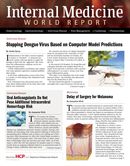Publication
Article
Internal Medicine World Report
Impaired Muscle Mitochondrial Biogenesis, Myogenesis Behind Spinal Muscular Atrophy
Author(s):
Research, led by Michela Ripolone, PhD, Centro Dino Ferrari, Universita degli Studi Milano, concluded that an altered regulation of myogenesis and a downregulated mitochondrial biogenesis contribute to pathologic changes in the muscle of patients afflicted with spinal muscular atrophy (SMA), recommending that therapeutic strategies aim at counteracting these changes.

Research, led by Michela Ripolone, PhD, Centro Dino Ferrari, Universita degli Studi Milano, concluded that an altered regulation of myogenesis and a downregulated mitochondrial biogenesis contribute to pathologic changes in the muscle of patients afflicted with spinal muscular atrophy (SMA), recommending that therapeutic strategies aim at counteracting these changes.
Their results were published online in JAMA Neurology on April 6, 2015.
The study investigated mitochondrial dysfunction in a large series of quadriceps muscle biopsy samples from 24 SMA patients with genetically documented disease and paraspinal samples from 3 patients with SMA-II undergoing for surgery for scoliosis correction.
Age-matched controls were healthy children 1 to 3 years of age who had undergone analysis for suspected myopathy.
Analyses were conducted from April 2011 to January 2015. Biochemical, histochemical, and molecular techniques were used to examine the muscle samples and to measure respiratory chain activity and mitochondrial content.
Histochemical analysis indicated cytochrome-c oxidase (COX) deficiency was more evident in muscle samples from patients with SMA-I and SMA-II. Muscle mtDNA content and cytrate synthase activity were also reduced in all 3 types of SMA. These changes to downregulation of receptor coactivator 1α, nuclear respiratory factors 1 and 2, mitochondrial transcription factor A, and their downstream targets suggested depression of mitochondrial biogenesis.
Furthermore, analysis confirmed reduced levels of the respiratory chain subunits including mitochondrially encoded COX1, COX2, COX4, and succinate dehydrogenase complex subunit A, as well as the structural outer membrane mitochondrial porin.
The data showed; however, levels of expression of 3 myogenic regulatory factors were higher in muscles from patients with SMA compared with muscles from age-matched controls.
The investigators said the present study strengthened the significance of these muscle-specific mechanisms for SMA pathogenesis as well as the importance of developing strategies aimed at improving residual muscle function and delaying disease progression.





